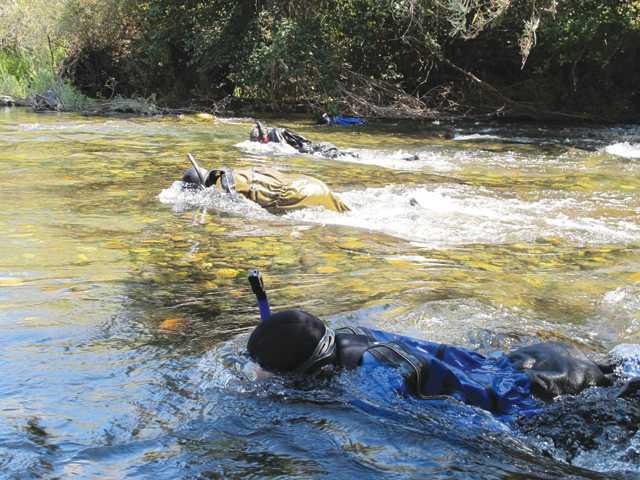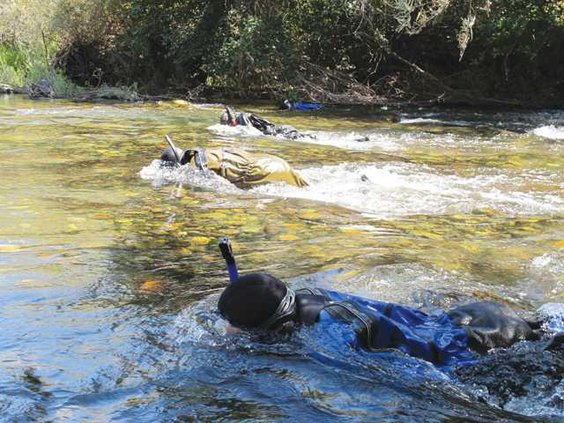State and federal management of water flows on the Stanislaus River being done in the belief that they will help boost the population of threatened steelhead is actually reducing their numbers instead.
FISHBIO — a fisheries research, monitoring and conservation firm employing scientist engineers and technicians with offices in Oakdale, Chico, and Santa Cruz — has been conducting extensive monitoring and research of young rainbow trout on the Stanislaus River since 2009. The trout have the potential to become steelhead when they migrate to the ocean.
The scientists have collected data they contend discredits the prevailing strategy of state and federal agencies to release more water from Melones Reservoir earlier in the year on the assumption “more flow equals more fish.” The government water managers have not provided research data to back up their working theory that has resulted in tens of thousands of acre feet of water being released resulting in no measurable impact on rainbow trout population. The early releases — particular in the current drought — have had detrimental impacts on urban, fam and even environmental uses of stored water.
The South San Joaquina Irrigation District and Oakdale Irrigation District have superior water rights to the Stanislaus River watershed and can be adversely impacted by state and federal management of water behind New Melones.
Between 2009 and 2014 FIOSHBIO estimated there were about 20,200 rainbow trout in peak years in the Stanislaus River. During that time the numbers never dipped below 14,000 fish. This abundance is due in part to high-quality habitat, particularly in Goodwin Canyon east of Knights Ferry, where fast-moving water, boulders and other features offer a diversity of hiding places and food for the fish. However, in 2015 the number of trout counted per river mile dwindled in the canyon by about 80 percent.
A FISHBIO report issued this week states that, “The average daily water temperature in the Stanislaus River reached 69 degrees Fahrenheit at Knights Ferry in August 2015, which is higher than any summer water temperature recorded since 1998. These warm temperatures were related to the exceedingly low water level in New Melones Reservoir (upstream of Tulloch and Goodwin dams), which was then at 12 percent of capacity. Trout and salmon prefer cooler water, so to protect these fish, the reservoir should ideally be managed to maintain a reserve of deeper, cold water. However, by summer 2014, the level of the reservoir had dropped too low for the water to remain cool, so the water released from New Melones was warm during that summer and even warmer during summer 2015. This likely had serious consequences both for trout living in the river and for eggs they laid during the winter.
“While the reservoir is now at nearly 24 percent capacity following a winter with decent precipitation, water temperatures in the river during 2016 have been similar to the warm conditions in 2014. FISHBIO’s upcoming trout survey will reveal the extent of the damage from consecutive warm years”
That surrey starts today with snorkel surveys in the Stanislaus River at Knights Ferry.
FISHBIO notes that “with the exception of extremely high flows that were released for flood control in 2011, water temperature has played a much bigger role than river flow in determining rainbow trout abundance — so much so that rainbow trout have declined even though flows have been relatively high in recent years, because water released from the reservoir has been too warm.”
“This drought is a good reminder that sometimes saving water for later release is better for fish than releasing too much at once,” said Doug Demko, president of FISHBIO. “We now have evidence that releasing stored water in a way that depletes cold water reserves can significantly reduce rainbow trout abundance.”
OID General Manager Steve Knell noted SSJID-OID started the fish population surveys in 2009 after the National Marine Fisheries Service “mandated higher flows to protect rainbow trout, without even knowing how many fish there were in the river.”
“We’ve suspected all along that higher flows don’t make more rainbow trout, and now we have the evidence to prove it.” Knell said.
The two irrigation districts that share joint rights to 600,000 acre feet of water on the Stanislaus River watershed have been sending $1 million annual on fish research and habitat restoration for rainbow trout.
The districts started doing so in the belief they had to be stewards of the river or risk having fish killed off which in turn could trigger federal intervention in water use.
FEDS KILLING FISH?
Research shows water release strategy cut fish numbers 80%





